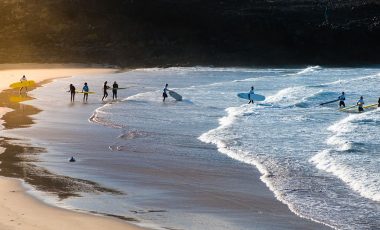Surfing is the art of riding a wave on a board and is very much loved world-wide. Whether you are young or old, surfing is an exhilarating sport and there is no better way to experience the power and beauty of the sea. It’s one of those sports that is indescribable until you’ve tried it. And once you’re up on your board, it’s hard not to get hooked!
The earliest known references to surfing date back to 12th Century Polynesian cave paintings, but it is thought to have been around for much longer than that. Since the first humans learnt how to build wooden boards and slide on waves, whole cultures based on surfing have spread around the world. In Hawaii it was so important that it played a crucial role in their society, to the extent that surfing was referred to as the sport of kings. We couldn’t agree more!
Surfing for beginners is the first step in their exciting journey of learning how to glide over the water using the power of the waves alone. Our surfing beginner guide will help you go from a total beginner to cruising on your first wave. It will help you understand what to expect from your first surf session, where to do it and what to wear. Plus, you’ll get some top surfing tips for beginners to get you started.
- Who can go surfing
- Where can I go surfing?
- What to expect from your first surfing session
- How to get started
- What to wear surfing
- Surfing tips for beginners
- Where to learn more about beginner surfing
Who can go surfing?
Whether you want to learn solo or with a group, surfing is a sport for everyone. With access to a wave anyone can learn how to surf.
One common misconception is that you have to be a strong swimmer to go surfing. As a beginner you will be standing in waist deep water, so if you can swim 25 m you will be able to safely learn. This makes it the perfect sport for water-loving families and children, too. Everyone can learn to be comfortable in the water as they share their first surfing experience.
Surfing is also a highly accessible sport for those with physical disabilities. Adaptive surfing is an established and growing movement in which individuals can enjoy surfing waves in a kneeling, seated or lying position. Many surf schools offer adaptive surfing lessons and some are dedicated solely to it. This means that everyone can learn how to surf and experience the joys of surfing.
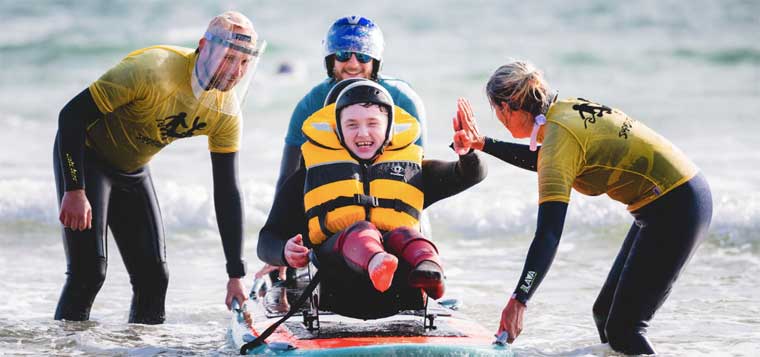
Image: Surfability UK CIC
Where can I go surfing?
There are many different types of waves, but only some are suitable for learning to surf. Beach breaks are the most beginner friendly as they offer safe white water waves and a soft sandy bottom. As your surfing improves you will be able to progress to point and reef breaks.
Lifeguarded beach breaks are the best places to learn as the lifeguards will mark out safe areas of the beach for surfers. For your first time surfing you should surf on beaches which are known to be good for beginners. These are beaches without strong currents and rips, and they normally come with a surf school attached!
Even if you aren’t lucky enough to live near the sea, inland surfing centres are becoming more common. These are incredible lakes that can produce perfect artificial waves and are a great place to learn how to surf for beginners as they are a totally controlled environment. The main downside to inland surfing centres is that they can be quite pricey.
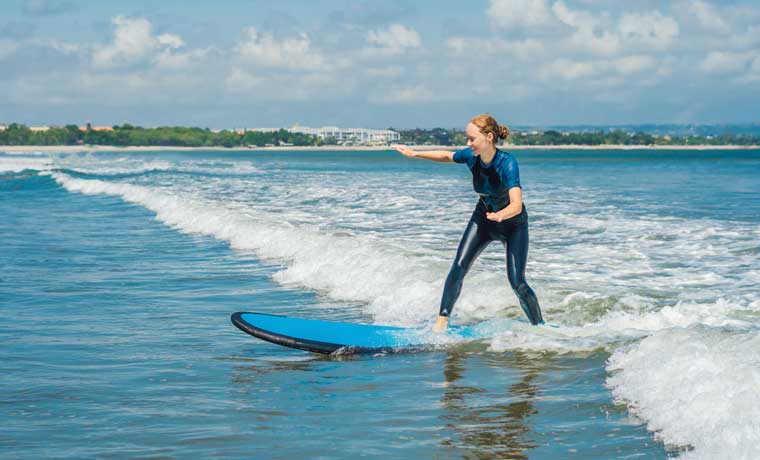
What to expect from your first surfing session
There is no doubt that surfing is a challenging sport. During your first session you will probably feel like you’re being pulled backwards through a washing machine. You’ll be exhausted, your arms will ache, and you’ll feel like you swallowed far too much water.
But you are also going to experience the enjoyment that makes the sport loved by so many people around the world. The benefits of surfing are numerous, and even before you get to your feet it will be so much fun. As you jump through the waves you’re going to be immersed in the sea and you will be able to fully appreciate the beauty around you.
If you do get to your feet during your first session you’ll feel the pure elation that comes with surfing a wave. It will be a fast and wobbly adrenaline filled ride that’ll leave you with the biggest smile and a desire to do it again!
Depending on how quickly you get to your feet you may feel frustrated, but keep trying because it will happen and when it does it’ll be worth all the effort.
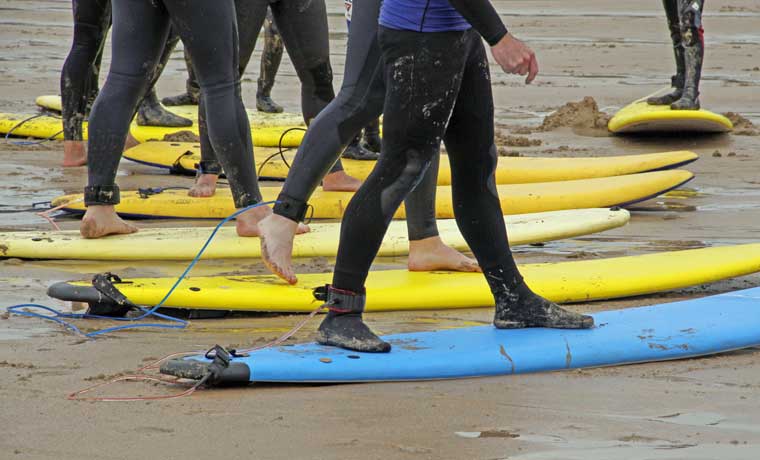
How to get started
Booking a lesson is the best way to go from total beginner to stylish surfer. Most beaches with beginner-friendly waves will have a resident surf school and if you’re learning at an inland surf centre they will have their own surf school attached. As part of the lesson you will be given all the correct gear and a suitable surfboard, so you will not have to buy or rent anything.
In the lesson you will be taught how to get to your feet and how to be safe in the water. As the coaches are able to watch you learn they can give you tips to improve your technique. This is really important as it is often hard to see what’s going wrong in the rush of the wave. Starting with a lesson will develop a strong foundation to your surfing which will help you progress faster.
If you are keen to jump in the water and just give it a go, you can always hire a foamy (beginner board) and practise in the waves. Just remember to make sure that the beach is suitable for beginners and to stay within your depth.
Another great way to get started is to go on a surf camp. These are often week long camps where you stay with a group of surfers as you learn. Spending consecutive days learning to surf will teach you a huge amount. You’ll be surprised by how much you have improved at the end of the camp. With everyone together in the water you’ll encourage and help each other out, and it’s a great feeling catching your first wave as everyone around you cheers you on!
What to wear surfing
What you wear surfing is dependent on the water and air temperature. These temperatures are different depending on your location and the time of the year. One of the best surfing tricks for beginners is that it’s better to be slightly too warm than too cold. This is because it is more comfortable being warmer and you will be able to surf for longer.
If you’re lucky enough to surf in warm waters you will be able to stay warm in board shorts or a bikini. Just make sure they are secure in the waves! You may also want to wear a rash vest for sun protection and to stop board rub.
In colder conditions a wetsuit is needed to keep warm. Wetsuits come in different thicknesses from 2-6 mm and the thicker the wetsuit the warmer it is. Thanks to modern technology there are wetsuits for every temperature, so you should never feel cold in the water.
Generally, 4-6 mm wetsuits are considered winter wetsuits and 2-3 mm are summer wetsuits. You can also get a shortie wetsuit for warmer conditions. And for the coldest temperatures there are wetsuit boots, gloves and hoods to keep your extremities warm.
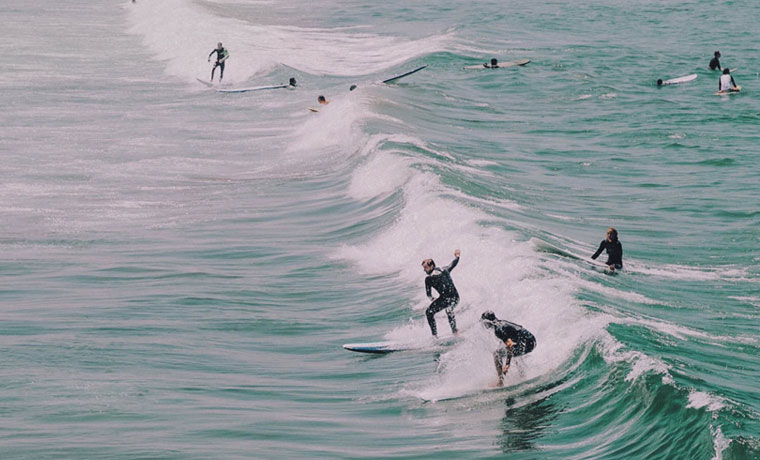
Surfing tips for beginners
01Wear the right thing
Make sure you wear the correct gear for the water temperature. There is nothing worse than getting really cold when you could be toasty and warm in the right wetsuit. If the sun is out don’t forget to wear high SPF waterproof and reef-safe sunscreen, as it is easier to get sunburned in the water.
02Ride the right board
Foam is your friend! This is one of the most important surfing tips for beginners. The bigger and floatier your board the better. You will catch more waves and be more stable when you spring to your feet. As a result, you’ll progress much quicker.
03Book a lesson
If possible book a surf lesson. They’ll have all the gear and will get you on your feet and cruising in no time. They will also be able to keep you safe in the water and give you things to improve upon or change.
04Check the conditions
Before you jump in the water make sure the conditions are suitable. Check that there are other beginners in the water. Plus, if there are lifeguards on the beach, surf where they tell you to, and never surf at a closed or red-flagged beach.
05Do a warm up
Always do a proper warm up on the beach before getting into the water. You’ll be using muscles you didn’t know you had and your body will thank you the next morning. These yoga poses for surfing are a good place to start.
06Practise your pop up!
Practise getting to your feet on the sand until you feel confident with your technique. Make sure your feet are shoulder width apart and your knees are bent for stability.
07Be board aware
When you’re in the water keep a lookout for everyone around you and always keep control of your board. Never hold your board by your leash as it can tangle in your fingers, and don’t hold your board sideways to the wave as it will be pushed back into you.
08Start in the whitewater
Aim to catch broken whitewater waves. To make sure that you catch the wave, always give three strong paddles before you get to your feet.
09Don’t give up!
Keep trying. If you’re very lucky you will get to your feet first try but for most of us it can take one or more sessions! Just remember the goal. When you ride your first wave all the struggle and swallowed water will fade away as you experience the wonderful feeling of surfing.
10Use your head
Where your head goes your body goes. All movement on a surfboard starts with the head. If you look at your feet you’ll fall into the water. So look up and forward to where you want to go and your surfboard will follow!
11Plan for after your surf
Always take warm clothes, a snack and water to drink for after your surf. You will be surprisingly hungry and the feeling of warming up after being in the water is incredible.
Where to learn more about beginner surfing
For more information on how to catch your first wave have a read of the websites of your national surfing governing body:
Or check out your local surf school / clubs where lessons and beginners meet-ups will be advertised.


